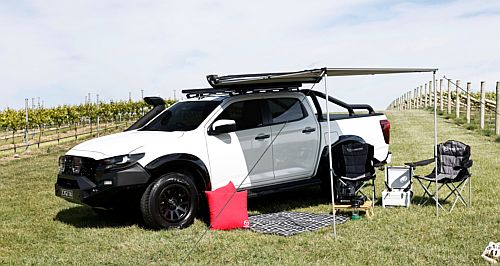Mazda expands accessories range for new BT-50

MAZDA’S newly facelifted BT-50 will offer buyers a greater range of factory-backed accessories than its predecessor that the brand says will fill the role of third-party flagships offered by other companies.
The BT-50's engineering twin, the Isuzu D-Max, has just gained a range-topping Blade variant developed with Walkinshaw, while Nissan has enjoyed plenty of success with its Premcar-developed Navara Warrior.
Of similarly low priority to an externally developed flagship BT-50 is electrification, at least not in the near future.
While Mazda is not under the same pressure to meet the stringent New Vehicle Emission Standard as other manufacturers which rely heavily on ute sales – such as Isuzu and Ford –Mazda Australia managing director Vinesh Bhindi mentioned a 2030 timeframe for an electrified BT-50, which suggests it is a next-generation prospect, despite Isuzu planning to produce an all-electric D-Max from next year.
Speaking to GoAuto at the global BT-50 reveal in Melbourne, Mr Bhindi said the company is “not looking at any other (third party) programs” to create a direct competitor to the just-launched D-Max Blade and popular Navara Pro-4X Warrior.
Mazda Australia executives told GoAuto the BT-50's extensive range of accessories – that runs to more than 100 items, including mechanical upgrades – fulfils that customer requirement.
The outgoing BT-50 SP Pro included Old Man Emu Nitrocharger twin-tube shock absorbers and a Lightforce LED lightbar, while the Thunder Pro included dual Lightforce LED driving lights and locally developed Old Man Emu BP-51 suspension.
Nitrogen-filled with a remote reservoir, the BP-51 dampers are manually adjustable for compression and rebound, enabling customers to tune the suspension to suit their needs.
While the Australian model line-up for the facelifted BT-50 is yet to be revealed, it is expected the range will largely mirror what is currently available.
“The BP-51 suspension is an incredibly sophisticated unit and it’s totally customisable,” explained Mazda Australia’s marketing director Alastair Doak.
“You can choose your own adventure with the settings on it. We have all our accessories that we’ll back and there’s very good engineering behind them, so we’re not really missing out on too much by not having one of those (third party partnerships).”
According to Bhindi, the average BT-50 customer spends between $3000-4000 on accessories, with some stretching to up $10,000.
“Usually a tow bar is a must, then as you go a little higher a bullbar becomes a must, then canopies and wheels, so it’s quite significant. And it’s not just for looks, it’s for practicality,” he said.
Mazda’s locally-developed bull bar is built by ARB and has been redesigned for the facelifted model to reduce weight and streamline the styling.
The accessories range covers everything from floor mats and seat covers to sports bars, driving lights, dual battery setups, roller tonneau covers all the way up to canopies and the complete suspension upgrades from the Pro models. All parts and accessories are covered by Mazda’s five-year/unlimited-kilometre factory warranty.
Australia is receiving its first electrified utes in the form of the BYD Shark and Ford Ranger PHEV but during the BT-50 reveal event, Mr Bhindi appeared unconcerned about being left behind.
“If you look at the ute market, electrification in that segment is just starting. And I know some brands are bringing the technology to market soonish, as opposed to when you compare that to SUVs and passenger cars,” he said.
“The ute segment is still to evolve, but there’s a difference when people are, in our experience, looking at a ute on the showroom floor, it has to be fit for purpose. They talk about the payload, they talk about towing, they talk about compelling value proposition. If those things are missing, they move on.
“All these new technologies are yet to be tested, are yet to establish what they’re good for and maybe initially it may fragment the ute segment further, where if you don’t have to really tow, you don’t have to have a crew of people in the ute with you, or if you’re not going to do off roading at all, maybe some of these powertrains make sense.
“I think this has got a longer-term evolution towards this technology, but in the end, new vehicle efficiency legislation is about CO2 reduction as opposed to a transformation to battery EV only, so we see our car, our packaging of the drivetrains, the value proposition (we) will bring to meet the market. And our view is we will always meet the market for all of those segments we compete in and bring the appropriate technology as it evolves.”